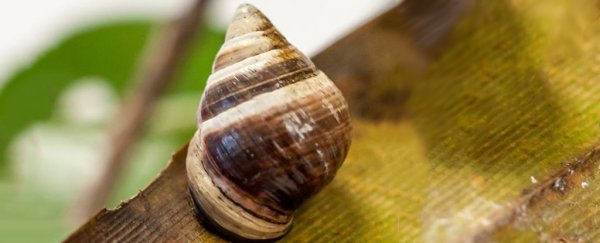George, a Hawaiian tree snail – also a 14-year-old local celebrity and the last known snail of his kind – will no longer be able to entertain school children, or eat tree fungus.
He died on New Year's Day, according to the Hawaii Department of Land and Natural Resources (DLNR).
The death of George, and the resulting extinction of this species of tree snail (Achatinella apexfulva), should serve as a wake-up call, highlighting a much larger issue in Hawaii's forests that's been going on for a century.
George the snail, named after the Pinta Island tortoise Lonesome George, never lived in a forest, being born in captivity and growing up in a lab.
As it happens, George was a hermaphrodite, but it seems that two snails of Achatinella apexfulva are required to produce offspring.
In times passed, these snails had a long adolescence, only reproducing a couple of times a year after the age of 4 or 5, and living relatively long lives (for snails).
"In 1997, the last 10 known Achatinella apexfulva were brought to a laboratory at the University of Hawaii for captive rearing," explains Hawaii DLNR on their Facebook page announcing the sad news.
"A few babies were born, but when the lab experienced a die-off for unknown reasons, all the Achatinella apexfulva perished except for one lone individual, and that was George."
As unfortunate as it was, this mysterious die-off is just another entry in a long line of human errors and environmental catastrophes that have decimated snail populations in Hawaii.
According to David Sischo, a snail extinction prevention program coordinator for the Hawaii Invertebrate Program, the first snail species that was ever written about by a non-native scientist was in fact Achatinella apexfulva, all the way back in 1780.
In those times, and even a hundred years later, snails were everywhere on Hawaii. According to National Geographic, there are 19th century records boasting how up to 10,000 snails could be collected in just one day.
Snails fulfilled a variety of purposes on the island, like helping plant matter decompose, or eating fungi on leaves – which may have protected their tree hosts from disease.
"Anything that is abundant in the forest is an integral part of it," Michael Hadfield, an invertebrate biologist who used to run the captive breeding program for rare native Hawaiian snails, told National Geographic.
But by the early 1900s, some snail species became extinct, due to Europeans collecting them like they were baseball cards (why did you think they knew they could collect 10,000 in a day?).
Alas, the Hawaiian snails had seen nothing yet. In 1955, the rosy wolfsnail (Euglandina rosea) was introduced into Hawaii to control for another invasive snail, the African land snail (Achatina fulica).
But as many of these introductions go, nothing went to plan. The wolfsnail eats other snails, and although it did munch through the African land snail population to a limited extent, it had a much larger appetite for native snails.
"We were just watching snails disappear, disappear, disappear," biologist Michael G Hadfield from the University of Hawaii told The Guardian.
"We could see them vanishing before our eyes."
Hadfield began studying the snails in the 1970s, and by the early 1980s, the populations had been decimated, and the scientists began conserving the snails, by bringing them into their labs.
It is thought that the rosy wolfsnail is responsible for the extinction of up to a third of the native gastropods.
Although this is a terrifying picture if you're a surviving Hawaiian tree snail, there is some good news.
There are thousands of native snails living at the Hawaii Invertebrate Program, and, according to Sischo, some snails have been re-introduced into remote forest areas. With any luck, in these remote areas, they will be free of both human and the rosy wolfsnail's clutches.
Let's just hope that George's death is the catalyst for stopping these extinctions – if we can get a handle on invasive species, not to mention climate change.
As DLNR writes so poignantly, "George, the last known Achatinella apexfulva, died on New Year's Day 2019 … he is survived by none."
